Here is the RecipeTin Family insider’s guide to the Top 10 BEST foods in Tokyo, Japan! Here we present to you our choices of the most famous foods of Japan and the best food Tokyo has to offer – This is our ultimate Top 10 Foods to Eat in Tokyo and where to try them!
This is a personal list put together by the RecipeTin Family, after much agonising and bickering! We’re a food obsessed family in Sydney, Australia. Our family is from Tokyo and it’s the city we know best when it comes to eating!
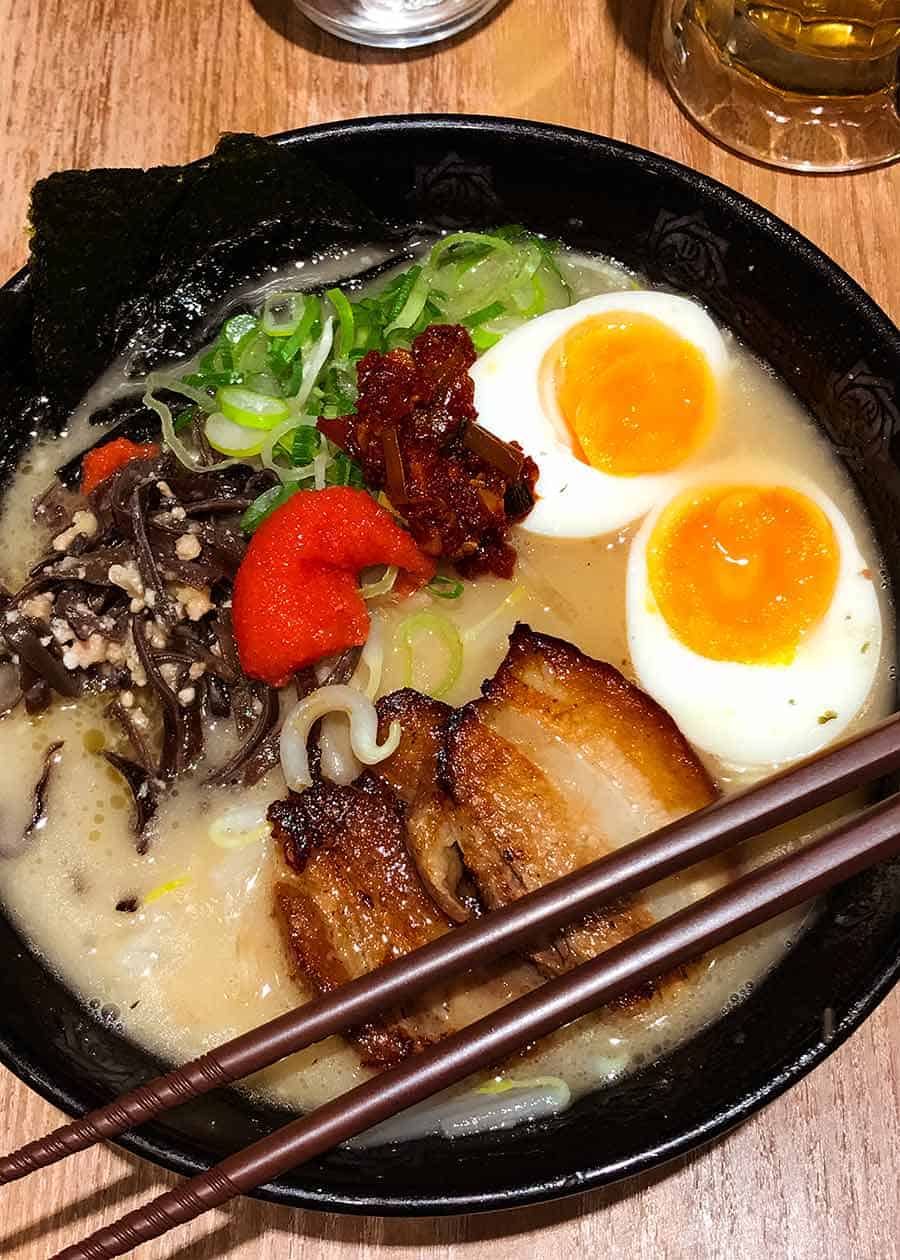
Top 10 Foods to Eat in Tokyo!
The “problem” with food in Tokyo is that there’s so darn much of it – and it’s all SO GOOD! In fact, it is hard to find bad food in Tokyo. You might come across the occasional “it’s ok” or “not to my taste”. But actual badly made food?
We’re yet to find any!
With so much food, so many choices, and so little time, what should you eat? And where should you eat it?
Welcome to the RecipeTin Eats Top 10 Foods to Eat in Tokyo!

Tokyo – the food capital of the world!
For many, food is one of the top reasons to visit Japan. If you’ve found our site, it probably in fact is the top reason you’re going to Japan!
Japan is without a doubt the most food-obsessed nation on the planet. With almost half a million restaurants, more Michelin stars than London, Paris and New York combined, and an endless number of food-related shops, this country offers just about anything a lover of all-things-edible could dream about.
While great food can be found across all of Japan, Tokyo is arguably the centre of the nation’s food universe. Here, the very best of nearly anything can be found – whether Japanese or foreign.
Tokyo is also where our family is from and the city we know best when it comes to eating!
So for us, as a Japanese family of food nuts, coming up with a list of the top ten foods to try in Tokyo was painfully difficult. We agonised and argued, butted heads and belittled, but we finally agreed on a list that we would happily recommend to travellers to Tokyo looking to try the best foods our home city has to offer.
So here it is: RecipeTin Eats’ Top Ten Foods to Eat in Tokyo and where to try them!
But first, let’s get the obvious out of the way:
Tokyo’s Michelin restaurants
Here is a current list of the Michelin-starred restaurants in Tokyo. While we appreciate fine dining and exquisite craft in food as much anyone, none of these are in our Top 10 list. For us, high end dining is not our bread-and-butter (so to speak!) when we eat out in Japan.
However we have been to a number of these award-winning establishments and can tell you that while it hurt our wallet, each and every one was a special and incredible experience we feel was worth every penny! We wholeheartedly recommend trying at least one Michelin or fine dining experience while you’re visiting.
1. Sushi

The food that is most associated with Japan is in no short supply in Tokyo. Sushi spans the entire spectrum of dining, from exclusive Michelin-starred establishments with just a handful of seats, to dirt cheap standing bars where office workers and students on a budget scoff down a cheap lunch.
While sushi can be found in almost every corner of the globe today, it’s the range of seafood and sheer quality that puts sushi in Japan head and shoulders above the pack. Put simply: There is sushi in the rest of the world — and then there is sushi in Japan.

You can eat great sushi on any budget, and truth be told we have been to only a handful of Michelin-type sushi restaurants. Our favourite sushi joints are casual, well-priced, and offer both an interesting and broad selection of spanking fresh fish to choose from.

Where to eat sushi: Nemuro Hanamaru, Marunouchi
Nemuro Hanamaru is a famous sushi chain from Hokkaido, the northern-most island of Japan known for its cold waters rich in bountiful seafood.
Yep, Nemuro Hanamaru is a kaitenzushi (conveyor belt sushi) restaurant. Don’t let that fool you though! At better kaitenzushi restaurants like Nemuro you can also request sushi to order. So leave the stuff circling on the belt to the amateurs and go pro: Order a la carte using the paper menu sheets for optimal freshness and choice (English menu available).
We love this sushi restaurant because it’s a rare find that ticks all our boxes. Top grade seafood? Check. Great service and efficiency? Check. Excellent variety with some special offerings beyond the usual? Check. Good prices and value for money? Check.
No wonder long queues form outside each day. We suggest going outside peak times, but even then be prepared to wait (take a number from their ticket system.)
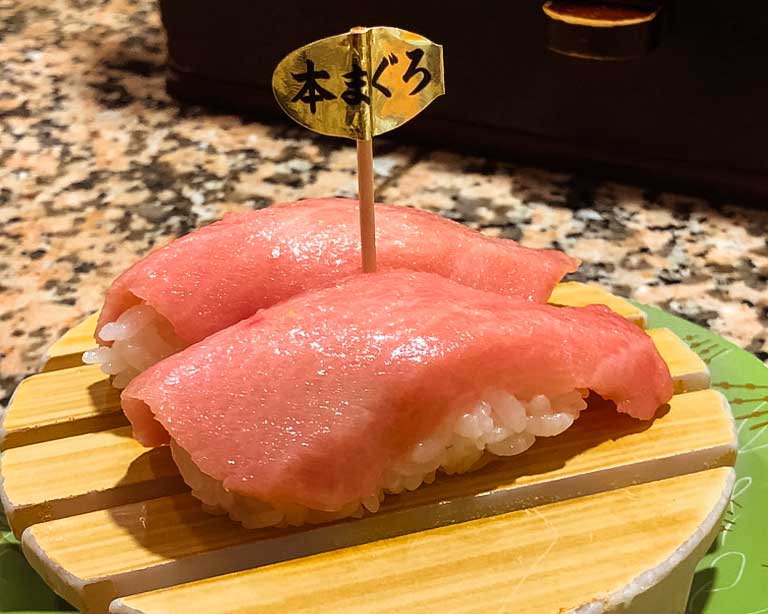
Don’t miss: O-toro (fatty tuna belly); shime-saba (vinegar cured mackerel); any Hokkaido-local fish; uni (sea urchin roe). For the adventurous: Anko (cooked monkfish liver); uncured salmon roe; kani-miso (crab tomalley and meat).
Address: 2 Chome-7-2 Marunouchi, Chiyoda-ku, Tokyo
Phone: +81 3 6269 9023
Open: Mon-Sat 11:00-23:00 (LO 22:00), Sun/PH 11:00-22:00 (LO 21:00)
Website (Japanese only)|Tabelog page
2. Ramen
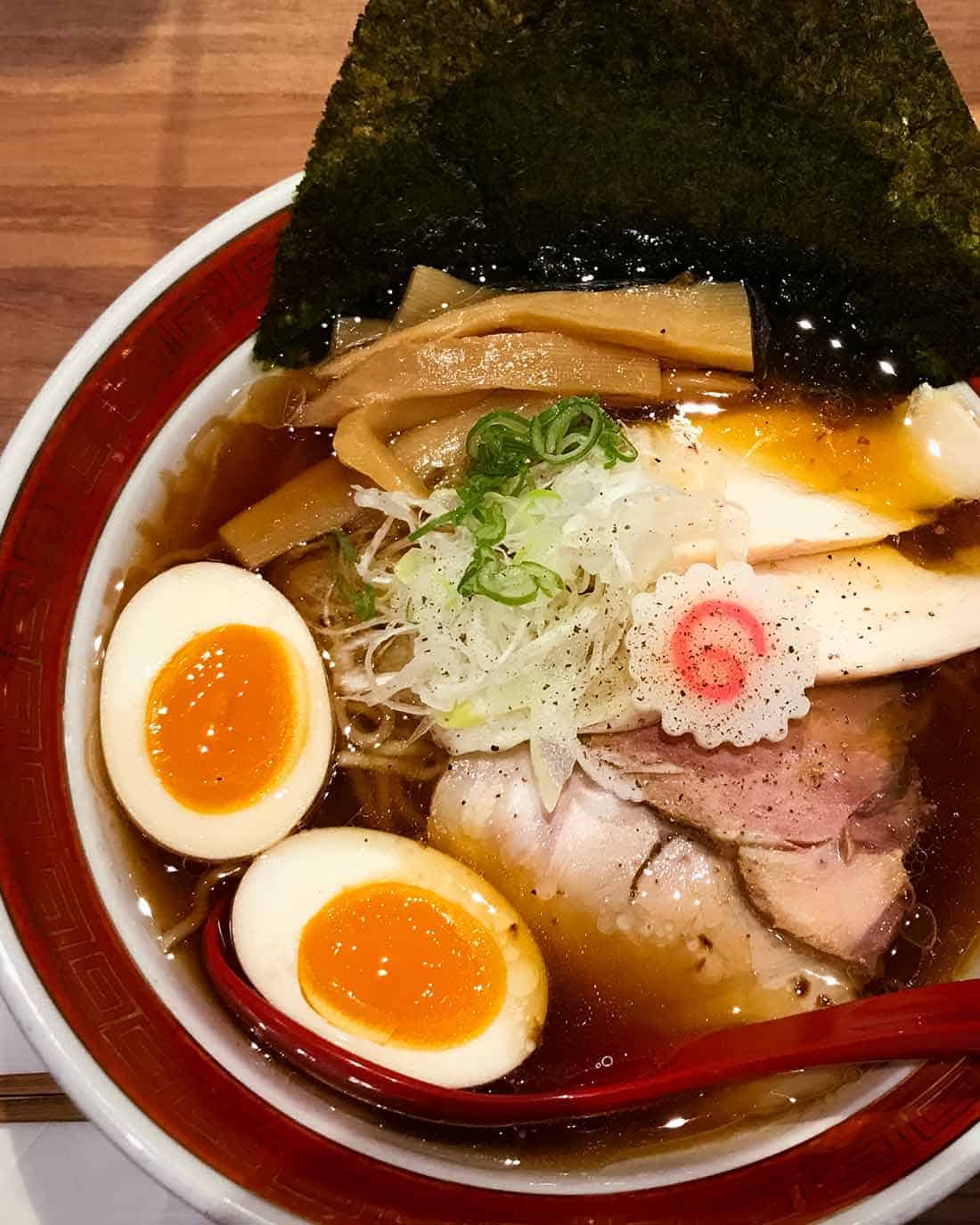
Having undergone something of a renaissance in recent years, ramen is more popular than ever today in Japan. The sheer number of ramen restaurants around today is staggering, and it feels like every street in Tokyo has at least one ramen-ya.
There are different regional styles of ramen as well as countless sub-variations within those, but the most popular and widely known ramen type is tonkotsu ramen.
This ramen has a rich, milky, lip-smacking soup base made by boiling pork bones for hours or even days.
Tonkotsu ramen broths range in heaviness, from the insanely rich and almost gravy-like, to much more delicate interpretations that almost(!) seem healthy. We like it somewhere in the middle, and our favourite pick in Tokyo would have to be famous tonkotsu king, Ichiran ramen.
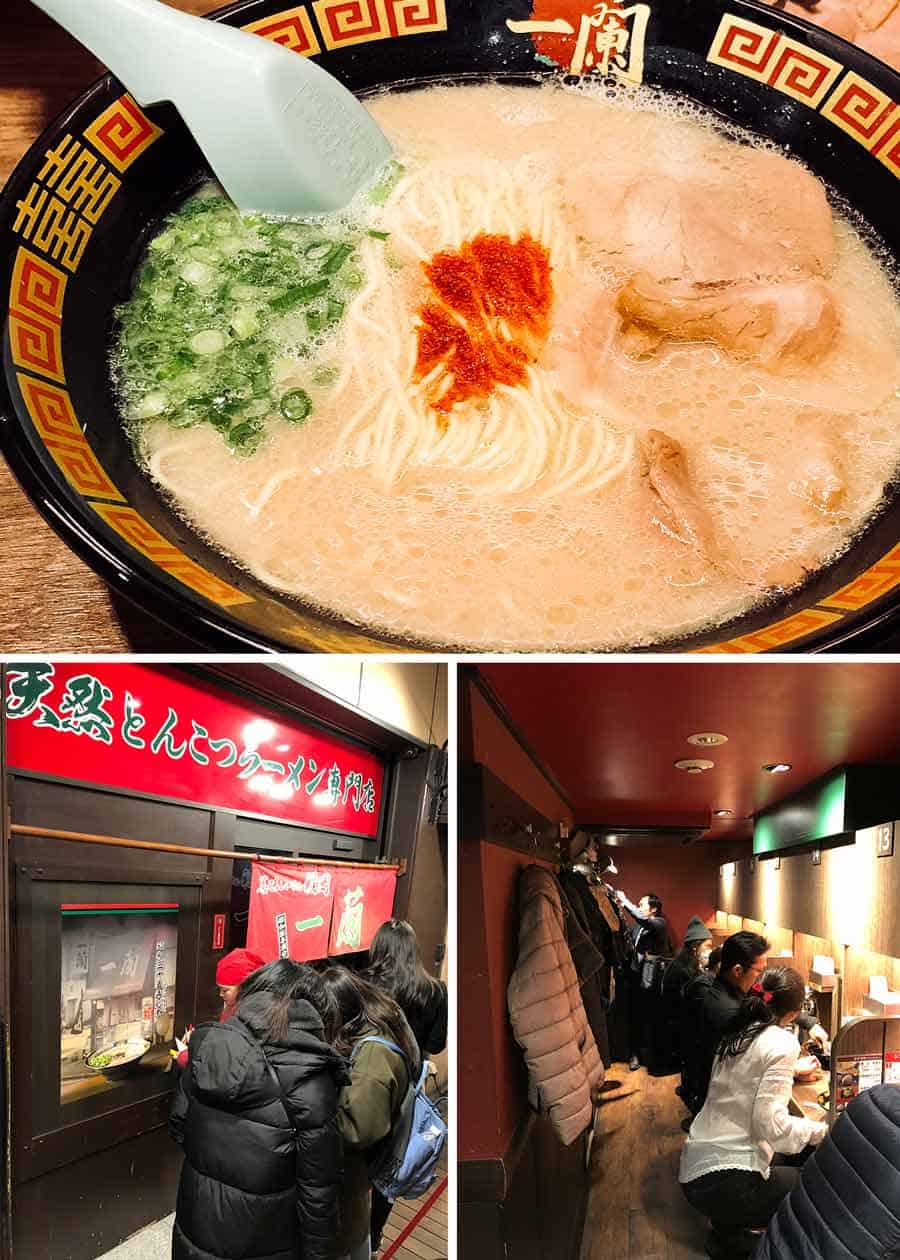
Where to eat ramen: Ichiran, Ueno and other locations
When it comes to tonkotsu ramen, Ichiran is one of the most widely loved ramen restaurants in Japan. Originally from Fukuoka, Ichiran have expanded nationwide to 60+ stores over the years.
In Tokyo alone there are over a dozen branches. Thankfully then, you are never far away from what we think is one of, if not the best, ramens around.
The broth is deeply flavoursome and rich yet at the same time somehow amazingly delicate. The thin noodles too have the perfect amount of bite (though you can specify the firmness). This is the ramen of your piggy noodle soup dreams.
Ichiran have a unique seating arrangement where diners at the counter sit separated from one another by dividers. It gives the diner a sensation of being in perhaps a confessional, a voting booth or an exam. Whatever the feeling, the point is entirely clear: Allowing you total focus on enjoying the bowl of supreme deliciousness before you.
If you have room for only one ramen in Tokyo, make it this one.
Address: 7 Chome-1-1 Ueno, Taito-ku, Tokyo. Also at Asakusa, Shibuya, Shinjuku, etc.
Phone: +81 3 5826 5861
Open: 24 x 7
Website|Tabelog page
3. Japanese Curry

The Japanese excel at taking a foreign dish and adapting it to local tastes, evolving it into something that is uniquely Japanese in character. Curry is one great example.
While still clearly recognisable as curry, Japanese curry has a silky and smooth consistency thanks to the roux used to thicken the curry. It is also generally sweeter, gentler on the heat factor and more rounded in flavour than the Indian curries they’re derived from.
Katsu-kare (curry with a fried breaded pork cutlet) is one of the most popular variations of Japanese curry and can be found everywhere across the country.

Where to eat Japanese curry: Joto Curry, Shibuya
A queue of salarymen at lunchtime often points the way to a cheap but tasty meal in Tokyo. We joined the line at Joto Curry recently on a hunch to see what the fuss was all about.
One mouthful and we instantly understood why Joto Curry is such a local hit. The rich sauce with spicing and sweetness perfectly on point, the katsu juicy with a beautifully crunchy coating – this is one of the best curries we’ve tried yet in Tokyo. The only thing we didn’t like? Staring at our empty, finished plates knowing there was no more to be had (for that day, anyway) …
It comes with enough rice to feed a sumo, so wear stretchy pants.
Don’t miss: Katsu-kare (curry with breaded, deep-fried pork chop)
Address: 3 Chome-18-7 Shibuya, Shibuya-ku, Tokyo. Also at Akihabara, Shinjuku, etc.
Phone: +81 3 6805 1477 (no reservations)
Open: Mon-Fri 11:00-22:00 (LO), SAT/SUN/PH 11:00-21:00
Website|Tabelog page
4. Yakitori
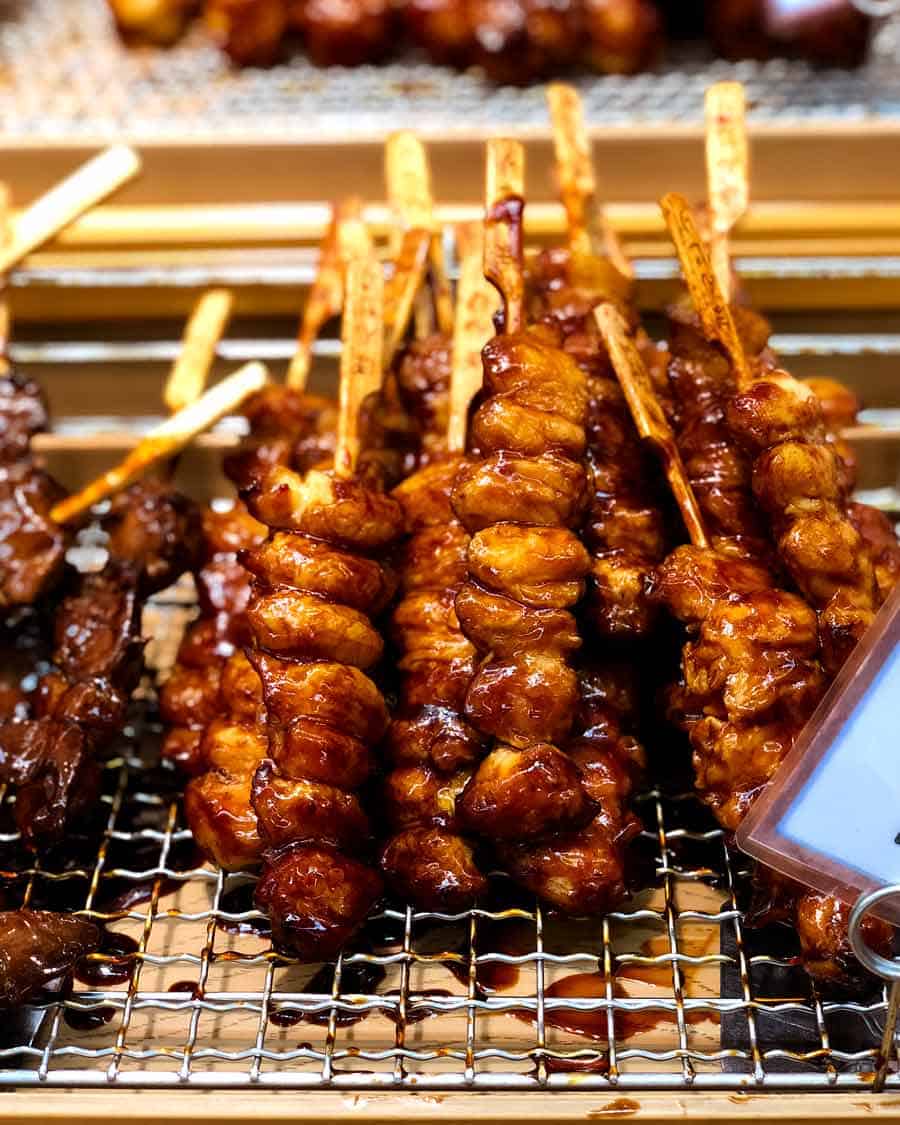
Every food culture on earth seems to have a barbecued meat-on-a-skewer dish dear to their hearts and the Japanese are no exception.
Over here it’s yakitori: Skewered chicken meat typically brushed with a sweet soy and mirin glaze, barbecued over charcoal. Appreciation of offal is also a part of Japanese food culture. So while chicken meat is a yakitori staple, you’ll find chicken hearts, liver, skin, gizzards and even soft cartilage also making appearances on proper yakitori restaurant menus.
Being cheap, casual and the perfect bar snack, yakitori is strongly associated with convivial eating and drinking amongst friends, co-workers and families. Going out for yakitori in the evening is a social gathering as much as a meal. For us this is our favourite way to enjoy this iconic Japanese food.
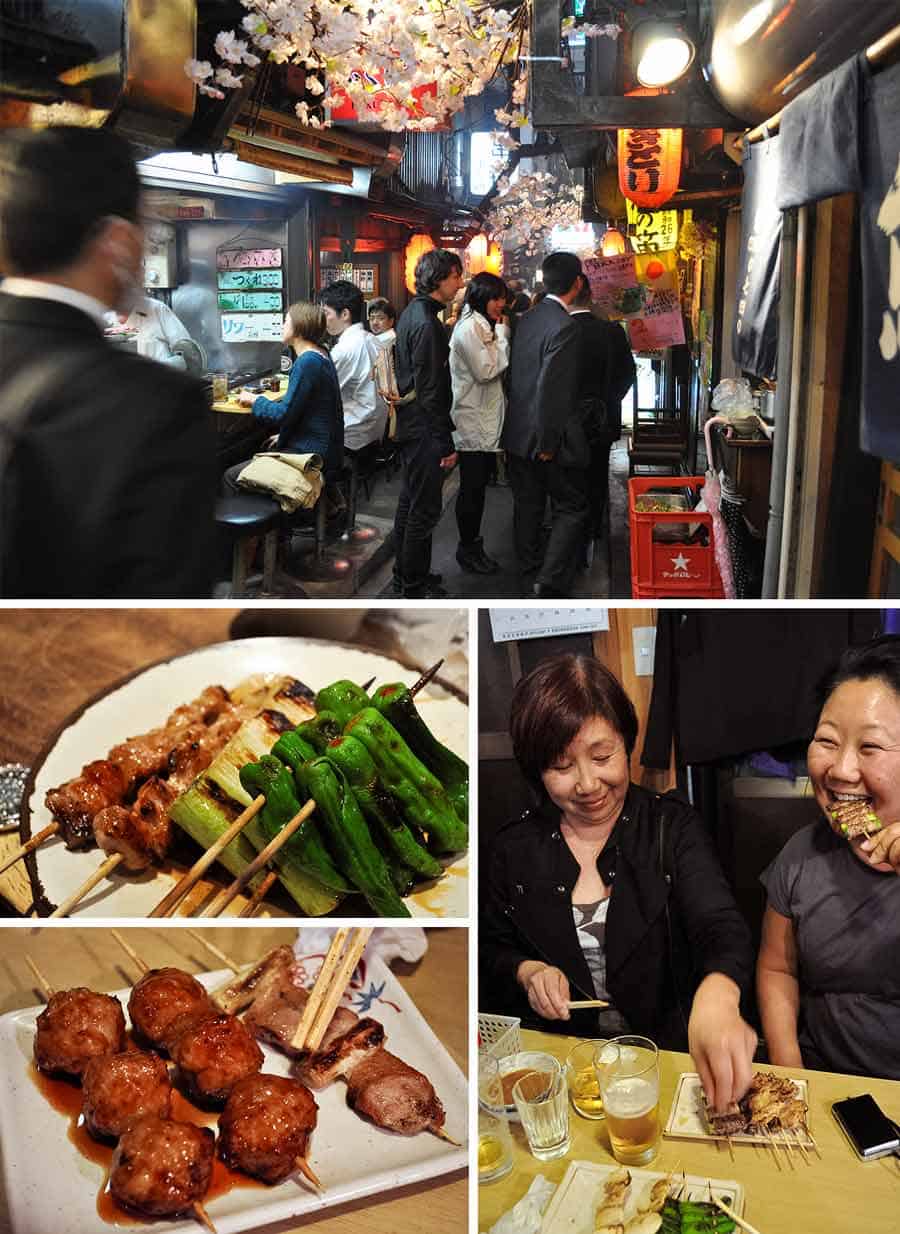
Where to eat yakitori: Yakitori restaurants inside Omoideyokocho (Memory Lane), Shinjuku.
Omoide-yokocho (“memory lane”), charmingly also called Shonben-yokocho (“piss alley”), is a narrow alley close to the Shinjuku railway lines housing dozens of tiny, shabby-looking eateries. You’ll smell the smoke from barbecuing meat before you even arrive, wafting from the little shops within. Many are tiny, seating maybe just 8 or so people.
This is where Shinjuku salarymen come after work to unwind with colleagues over a few skewers of yakitori, maybe a bowl of offal stew or some soba (buckwheat noodles), all washed down with some cheap grog.
We love the casual food and old-school atmosphere, and have great memories of boozy nights here scoffing tasty things on skewers. English menus may or may not be available, so be prepared to suss out places that do or deploy the old point-at-that-guy’s-food.
Don’t miss: Our favourite yakitori types – negima (chicken thigh with scallion); bonjiri (chicken tail / Parson’s nose), tebasaki (chicken wings); butabara (sliced pork belly). Ask for tare (soy glaze) flavour for the chicken, unless you prefer the lighter taste of plain salt.
Address: 1 Chome-2 Nishishinjuku, Shinjuku-ku, Tokyo
Website
5. Wagyu Beef

Wagyu beef in Japan can be enjoyed in different forms, but for us yakiniku (Japanese barbecue) or teppanyaki are our favourite ways to savour this special food. Both these types of restaurants offer a variety of cuts, grades and sometimes provenances of beef to try. The beef is usually grilled at the table unadorned and without a marinade, only served with a little sweet dipping sauce if required.
It’s true that wagyu beef is very expensive. However you don’t have to go overboard with spending. With meat as rich as this, a little goes a long way. Even those on a tight budget can still get a taste of the wagyu beef experience – Try the standing yakiniku restaurant Jiromaru in our Shinjuku section!

Where to eat wagyu beef: Mansei, Akihabara
Niku no Mansei is serious about beef. They have an entire ten storey building dedicated to the craft of serving top quality cow cuts in one form or another.
The lowest floors consist of a cafe and family restaurants that have a wide variety of dishes, not just beef. The higher floors serve yakiniku, sukiyaki, shabu-shabu, and teppanyaki on the top floor where we went.
Here we had what is hands down the best beef we have probably ever eaten. The heavily marbled wagyu beef steak is carefully seared on the hotplate by a chef in front of you, sliced into cubes and served (not thrown – that’s a silly entertainment gimmick only seen outside Japan!)
Chewing is optional. The beef literally melts in your mouth like butter as your eyes mist over and roll back in your head. This. Is. Heaven.
Don’t miss: Wagyu beef, teppanyaki style
Address: 12 Chome-21 Kanda Sudacho, Chiyoda-ku, Tokyo
Phone: +81 3 5294 1210 (10F enquiry & reservation), +81 50 5872 4125 (general reservations), +80 3 5294 1204 (general enquiry)
Open (10F): Mon-Sat 11:30-23:00 (LO 22:00), Sun/PH 11:30-22:00 (LO 21:00)
Website|Tabelog page
6. Tonkatsu

A cousin of the schnitzel, tonkatsu is a thick pork cutlet, breaded then deep fried to a golden crisp, and is every bit as good as it sounds.
The very best tonkatsu has an amazingly crispy but not oily crust. Inside is juicy, melt-in-your-mouth pork, ideally from breeds prized for their flavour and tenderness like kurobuta (black or Berkshire pig).
Tonkatsu is usually served with a sweet-savoury sauce (often made in-house), with cabbage on the side as a refreshing salad along with rice.
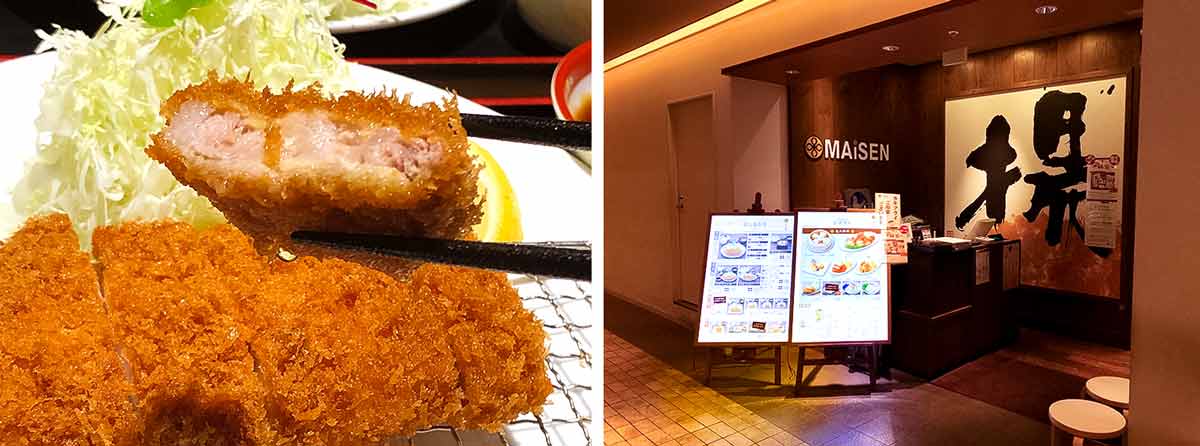
Where to eat tonkatsu: Maisen, Shibuya
Maisen has been in business since 1965 and is one of the most famous tonkatsu restaurants in the city. In their own words, their tonkatsu is so tender “you can cut it with a pair of chopsticks”.
Every ingredient for the tonkatsu at Maisen is carefully prepared from scratch. The way the pork is cut, the specially crafted breadcrumbs, the oil blend, and the house-made sauce recipes they’ve honed over decades — every piece plays a part in coming together in a symphony of tonkatsu perfection. Maisen’s remains hands-down the best we tonkatsu we have ever tried.
The Aoyama branch is the original, with a few other locations around the city including two in Shibuya.
Don’t miss: Kurobuta tonkatsu loin set
Address: 4 Chome-8-5 Jingumae, Shibuya-ku, Tokyo. Also at Shibuya, Tokyo Daimaru department store, etc.
Phone: +81 120 428 485
Open: 11:00-22:45 (LO 22:00) daily
Website|Tabelog page
7. Soba
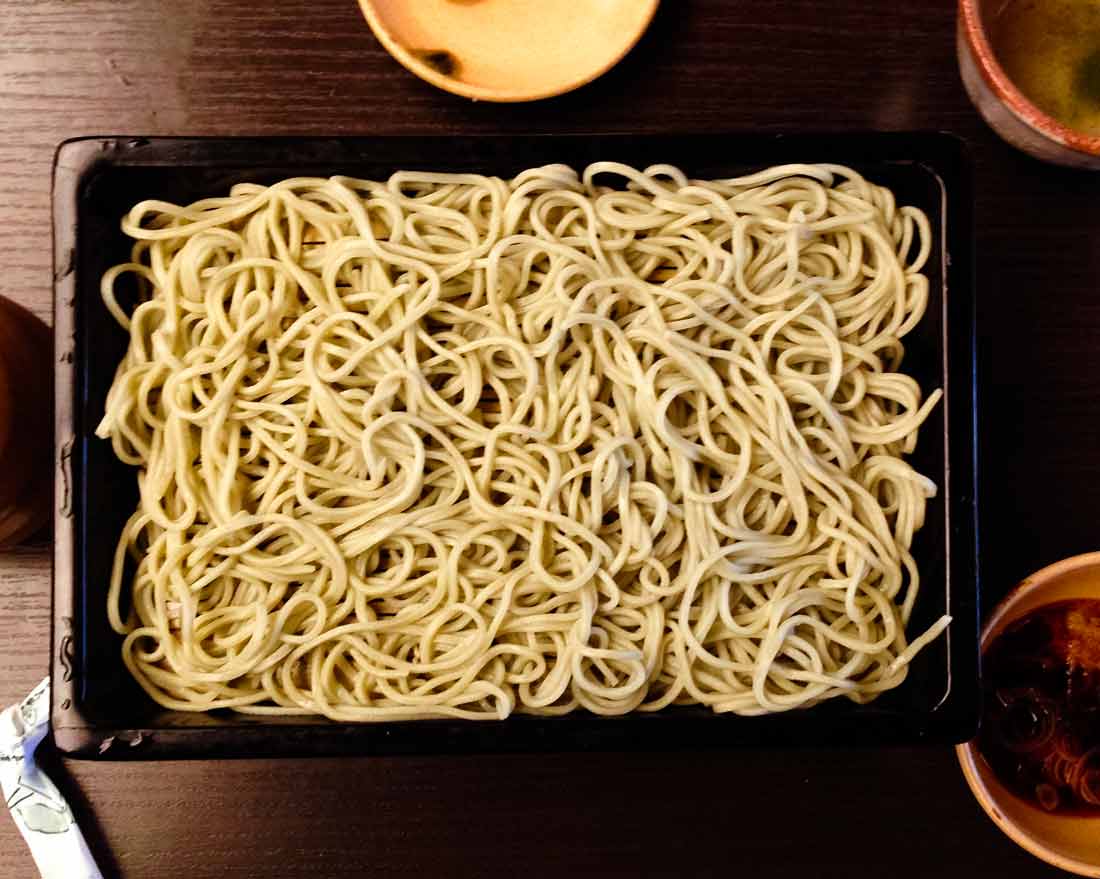
Hand made soba is a thing of beauty. It takes an immense amount of experience and skill to produce high quality soba by hand, and the best soba makers are revered for their craft. Soba made by such artisans has a chewy texture and nutty flavour a world away from mass produced or dried stuff.
Soba can be eaten hot or cold. While cold is preferred by purists, a piping hot bowl of soba in dashi broth is just as delicious – especially if the weather calls for it.
While plain soba is perfectly reasonable, accompaniments are usually offered alongside the soba. Tempura is one of the most classic side dishes typically served, and is a great choice to have with your soba.

Where to eat soba: Kanda Yabu Soba, Kanda
Established in 1880 (though rebuilt after a fire in 2013), Kanda Yabu Soba is one of the oldest soba restaurants in Tokyo and are famous for their hot and cold soba dishes.
Our Tokyo uncle brought us here for our first taste of traditional cold soba and it still remains the best soba experiences we’ve ever had.
Ten-seiro soba is one of their signature sets, where you receive a helping of cold soba noodles and a large mixed prawn tempura patty on the side. The rich and crunchy tempura is the perfect counterpoint to the chilled noodles dipped in soba sauce.
Reservations are possible (8 seats are available every hour by calling in advance) but you’ll need a Japanese speaker to call. Otherwise, be prepared to queue.
Don’t miss: Ten-seiro soba set (cold soba noodles with prawn patty tempura)
Address: 2 Chome-10 Kanda Awajicho, Chiyoda-ku, Tokyo. Also at: Otemachi, Senzoku, Shibaura, etc.
Phone: +81 3 3251 0287
Open: 11:00-20:30 (LO 20:00), Closed on Wed.
Website (Limited English)|Tabelog page
8. Tempura

If there is one eating experience in Japan we’d recommend splurging on, we think it’s tempura. There is nothing wrong with cheap and cheerful Tendon Tenya chain or your neighbourhood tempura-don (tempura on rice bowls) joint.
But a meal at a real tempura restaurant is a universe apart. Here the chef has been doing nothing but fine tuning for decades the art of delicately frying bite sized pieces of the freshest of seafoods and vegetables.
Dining is typically a bespoke tasting menu (omakase), where ingredients carefully selected by the chef arrive one perfectly fried morsel at a time over the course of the meal.
While high end sushi can be had in various major cities around the world, fine omakase tempura restaurants are virtually non-existent outside Japan, which makes it an even more unmissable experience in our view while you’re in Tokyo.
We’d also argue that unlike sushi, where pricing can venture into the sort of three figure pricing range that makes you spit four letter words, tempura tends to be a more affordable affair.

Where to eat tempura: Tenmatsu, Nihonbashi
A recent find and conveniently located just north of the Nihonbashi bridge, Tenmatsu ticked all the boxes for us as far as tempura restaurants go.
We loved chatting with the friendly chef and smiling waitstaff, the cosy atmosphere without the stuffy formality of really upmarket establishments, and of course the excellent tempura.
Various meal formats are available. They range from simple tendon (tempura on a rice bowl) sets at lunch, to the most elaborate omakase option.
If choosing the omakase menu, the ingredients are selected by the chef. One by one ingredients are carefully fried and served a piece at a time on to a paper-lined plate in front of you as they emerge from the fryer. Each morsel is so finely fried at Tenmatsu they barely leave a trace of oil on the paper.
Prices are very reasonable, with meal options to suit all ranges of budgets.
Don’t miss: Omakase tempura meal
Address: 1 Chome-8-2 Muromachi, Nihonbashi, Chuo-ku, Tokyo (Map)
Phone: +81 3 3241 5840
Open: Mon-Fri lunch 11:00-14:00, Sat/Sun/PH lunch 11:00-14:30, dinner 17:00-21:00 (LO) daily
Website|Tabelog page
9. Unagi
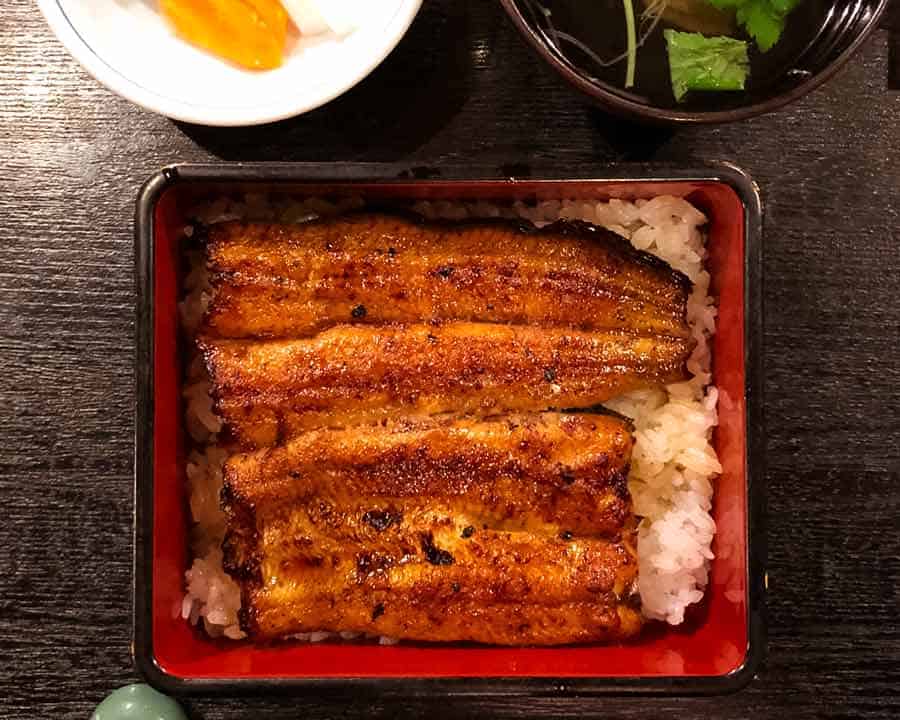
Unagi, or freshwater eel, is revered in Japan for its rich and fatty flesh, a delicacy whose history goes back hundreds of years. High quality unagi is always grilled over charcoal. The eel is painted with a thick, sweet glaze called tare and served over rice.
At restaurants that specialise in unagi (called unagi-ya) you might occasionally be served other parts of the eel as an appetiser. This might include deep-fried bones or the liver served in soup.
While unagi can be found at sushi restaurants (in sushi form), food halls and shokudo (restaurants serving a variety of Japanese meals), visit a specialty restaurant for the best experience.
Unagi is expensive but most restaurants will offer different portion sizes which are priced accordingly.
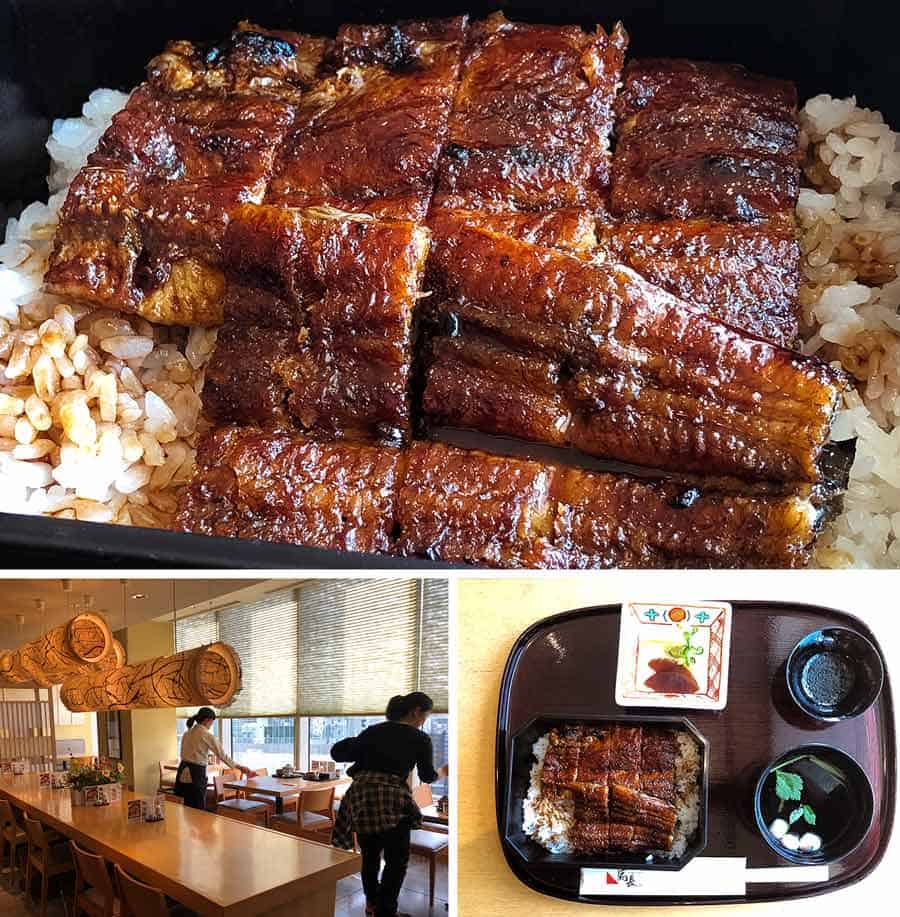
Where to eat unagi: Hitsumabushi Binchotan, Ginza
We had never tried Nagoya-style unagi (freshwater eel) until sitting down to some at the excellent Hitsumabushi Bincho Ginza. The unagi is only grilled (not steamed in addition, as is usual) over special binchotan charcoal until crispy, giving the eel a deliciously smoky flavour.
Nagoya-style eel also involves a particular way of serving known as Hitsumabushi. In this style of eating, the eel on rice is enjoyed a number of different ways: plain, with condiments, and then also with green tea or broth added.
If you feel like a more standard introduction to unagi, there are simpler sets. We’d recommend getting either the eel-on-rice bowl (smaller) or eel-on-rice box (larger) set with the soup and pickles. Servings are generous and come with a fair bit of rice, so you’re sure to be full.
Don’t miss: Una-don (eel on rice bowl) or una-ju (eel on rice box, larger)
Address: Marronnier Gate 12F, 2 Chome-2-14 Ginza, Chuo-ku, Tokyo (Map) Also at: Marunouchi, Ikebukuro, Tokyo Skytree Town.
Phone: +81 3 5159 0231
Open: lunch 11:00-15:30 (LO 15:00) daily, dinner Mon-Thu/Sun/PH 17:00-23:00 (LO 21:30), dinner Fri/Sat/pre-PH 17:00-23:00 (LO 22:00)
Website (Japanese only)|Tabelog page
What to order: Una-ju (unagi on rice served in traditional lacquered wood box)
10. Yoshoku
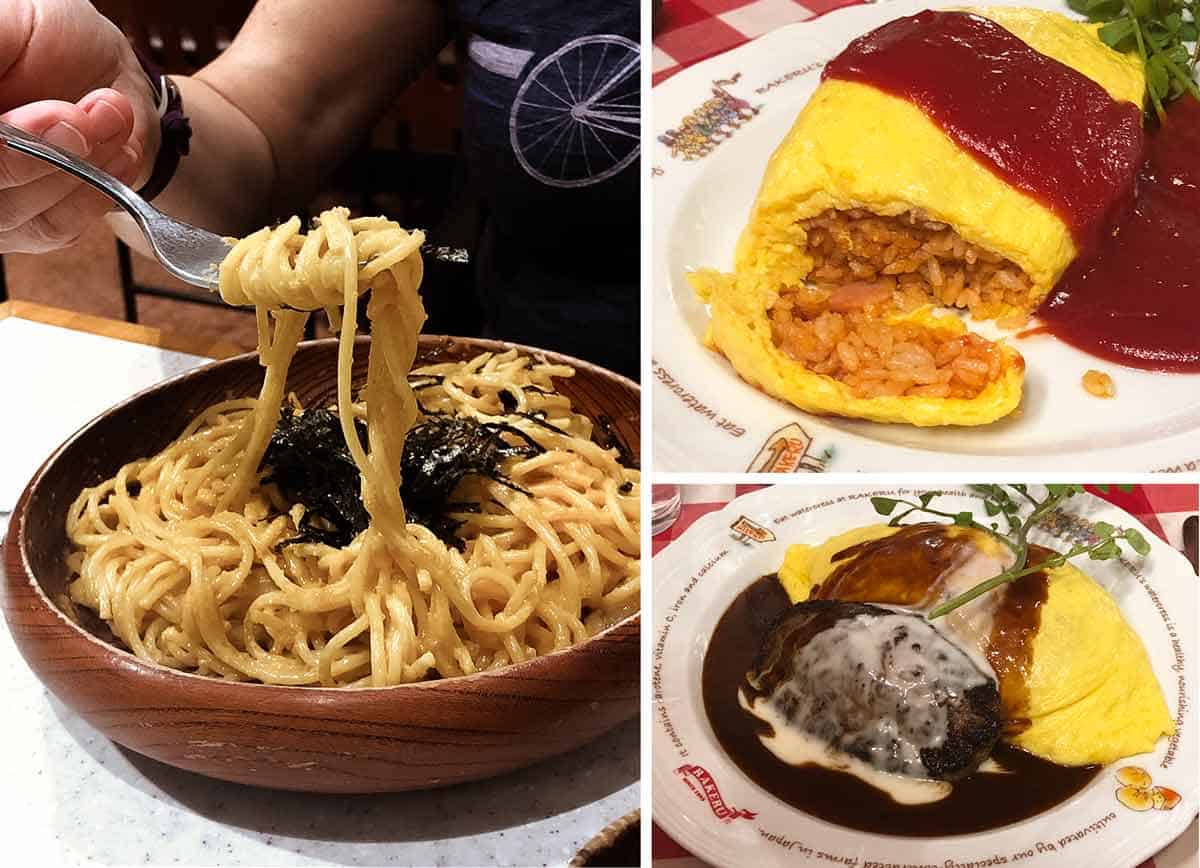
Yoshoku literally means “Western food” but refers specifically to Japanese-style Western food. You can think of it as a kind of fusion food, where Western dishes have been adopted but given a Japanese twist through the ingredients and preparation. The result is unique dishes that at once familiar yet distinctly Japanese.
Common yoshoku dishes include omurice (omelette on rice), hambagu (hamburger patties served with demi-glace sauce), pizza and pasta with Japanese ingredients such as cod roe and nori. Tonkatsu and Japanese curry, covered above, also come under the yoshoku umbrella.
We love yoshoku as much as we love traditional Japanese food and are always on the hunt for tasty new yoshoku dishes to try!
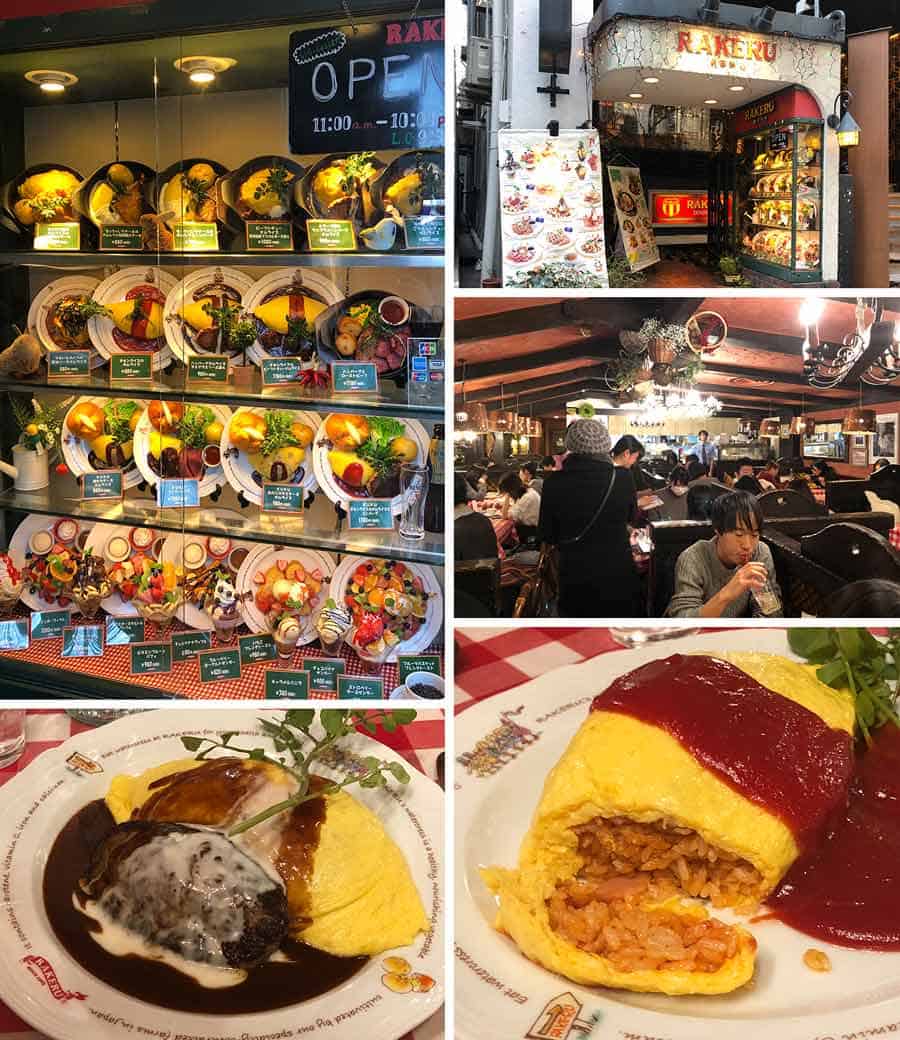
Where to eat yoshoku: Rakeru, Shibuya
Rakeru is a yoshoku restaurant that has been around since the 1960s. The kitsch interior and waitresses in cutesy maid uniforms is apparently supposed to channel an Alice In Wonderland theme.
This establishment is famous for the yoshoku classic, omurice. Here, immaculately prepared omelettes are served over flavoured rice, with a choice of sauces, rice flavours and additional accompaniments available (even a hamburger patty!) Roast chicken, roast beef, soup and the like are also available.
There’s also a range of giant sundaes and desserts to finish — just in case you’re feeling it’s a five-digit calorie kinda day.
Don’t miss: Omurice with hamburger and demi-glace sauce
Address: B1F 1 Chome-12-9 Shibuya, Shibuya-ku, Tokyo. Also at Ikebukro, Shinjuku, etc.
Phone: +81 3 3407 9221
Open: 11:00-22:00 daily
Website (Japanese only)|Tabelog page
Want more?
If you got as far down as this line, we know you’re already drooling like Pavlov’s dog right now. It’s understandable.
With so many incredibly tasty things to try in Japan, whittling a list down to a mere ten does neither the nation nor reader true justice.
But fear not. We have plenty more recommendations for other delicious Japanese food in Tokyo to sink your teeth into in the “Best Foods” section within each of our Tokyo Travel Guide Area Guide pages:
What to do in Tokyo – individual Area Guides
Quick links to separate pages for individual Area Guides for the main areas of interest for visitors to Tokyo. Each of these contains: what to do, our recommended highlights, how to get there, map, what to eat and where to eat it!
Asakusa / Shinjuku / Shibuya / Harajuku / Tokyo Station / Imperial Palace / Ginza / Ueno / Akihabara
See our Tokyo Guide!
Also, don’t miss our overarching, ultimate Tokyo Travel Guide! This a culmination of a lifetime of travelling to Tokyo, condensed into one place!!



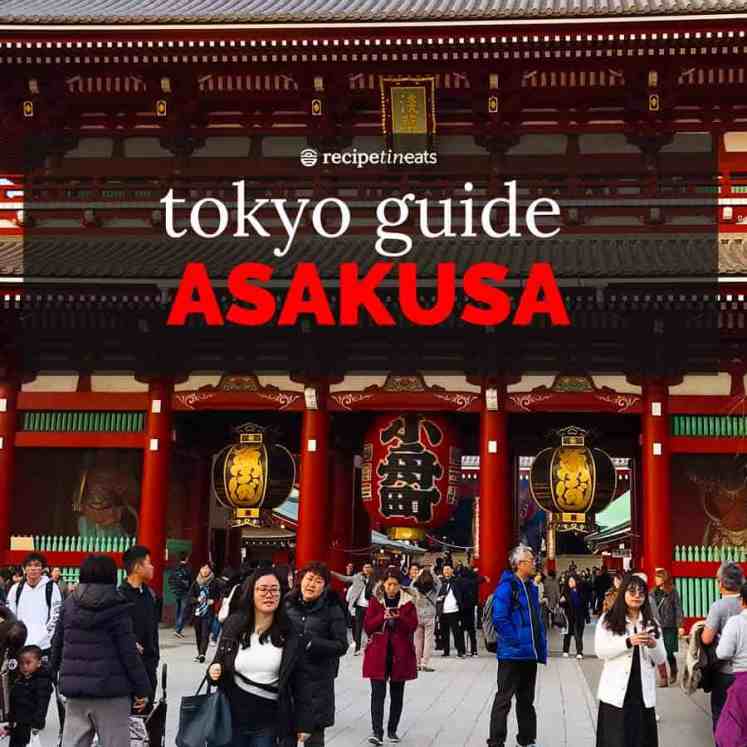

I spent 3 yrs in Japan while in USAF. I miss authentic Japanese cuisine. Does anyone have a recipe for Pork Katsudon?
My mother does Lisa!! Check out her blog here for authentic Japanese recipes! N x https://japan.recipetineats.com/katsu-don-pork-cutlet-and-egg-on-rice/
Japan is my first destination where I would like to be, waiting for opening borders. Thank you for this guide.
My husband and I are taking his parents to Japan in a few weeks, and we’re excited to try a few of your recommendations. Thank you so much for taking the time to share your favorite restaurants.
You’re so welcome Kim, enjoy!!
Being a big fan of Japanese food, I am drooling after reading this post!
I would add imakatsu in roppongi to the list of best Katsu in Tokyo!!